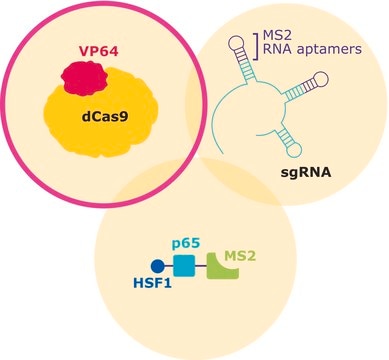DCAS9P300VP
Sigma CRISPR dCAS9-p300V Activator Lenti Plasmid
Se connecterpour consulter vos tarifs contractuels et ceux de votre entreprise/organisme
About This Item
Code UNSPSC :
12352200
Nomenclature NACRES :
NE.02
Produits recommandés
Produit recombinant
expressed in E. coli
Niveau de qualité
Forme
liquid
Conditionnement
vial of 50 μL
Concentration
20 ng/μL in TE buffer; DNA (1μg of plasmid DNA)
Application(s)
CRISPR
Conditions d'expédition
dry ice
Température de stockage
−20°C
Description générale
This gene activation system is based on a fusion of inactive Cas9 (dCas9) to the catalytic histone acetyltransferase (HAT) core domain of the human E1A-associated protein p300. The dCas9-p300 activator lenti plasmids use the EF1 alpha promoter for strong expression of dCas9-P300 and blasticidin linked by a 2A peptide (EF1a-dCas9-P300-2A-Blasticidin) allowing for easy selection following successful transfection or transduction. Use Sigma′s lentiviral dCas9-P300 lenti plasmid for generation of lentiviral particles and efficient production of stable cell lines expressing dCas9-P300 for CRISPR based gene activation. The dCas9-P300 lenti plasmid is one part of a two part CRISPR system with individual dCas9-P300 and gRNA expression vectors.
To order gRNA in any format click here
To order gRNA in any format click here
Application
- Functional Genomics/Target Validation
- Epigenetic Modification
- Transcriptional Activation
- Manufacture of dCas9-P300 expressing lentiviral particles
Caractéristiques et avantages
The Sigma CRISPR dCas9p300V plasmid co-expresses p300-HAT and Blasticidin, allowing for blasticidin based selection of cells expressing dCas9p300. gRNAs can successfully direct nuclease-deficient Cas9 (dCas9) fused to p300 HAT catalytic domain to increase levels of histone acetylation and endogenous gene expression. The dCas9-p300 histone acetylation approach represents a distinct mechanism of action relative to dCas9-VP64 or other similar gene activation motifs.
Principe
CRISPR/Cas systems are employed by bacteria and archaea as a defense against invading viruses and plasmids. Recently, the type II CRISPR/Cas system from the bacterium Streptococcus pyogenes has been engineered to function in eukaryotic systems using two molecular components: a single Cas9 protein and a non-coding guide RNA (gRNA). Mutations to the catalytic domains, RuvC and HnH, render it inactive as a nuclease yet still allow for the protein to be programmed to target specific sequences of DNA with a single gRNA. A fusion of dCas9 to the catalytic histone acetyltransferase (HAT) core domain of the human E1A-associated protein p300 induces transcription by releasing DNA from its heterochromatin state allowing for continued and robust gene expression by endogenous cellular machinery. The dCas9-p300 CRISPR Gene Activator represents a distinct mechanism of action relative to dCas9-VP64 or other similar gene activation motifs
Informations légales
Code de la classe de stockage
10 - Combustible liquids
Classe de danger pour l'eau (WGK)
WGK 2
Point d'éclair (°F)
Not applicable
Point d'éclair (°C)
Not applicable
Certificats d'analyse (COA)
Recherchez un Certificats d'analyse (COA) en saisissant le numéro de lot du produit. Les numéros de lot figurent sur l'étiquette du produit après les mots "Lot" ou "Batch".
Déjà en possession de ce produit ?
Retrouvez la documentation relative aux produits que vous avez récemment achetés dans la Bibliothèque de documents.
Notre équipe de scientifiques dispose d'une expérience dans tous les secteurs de la recherche, notamment en sciences de la vie, science des matériaux, synthèse chimique, chromatographie, analyse et dans de nombreux autres domaines..
Contacter notre Service technique




![4-Chloro-3′-formyl[1,1′-biphenyl]-3-carboxylic acid AldrichCPR](/deepweb/assets/sigmaaldrich/product/structures/219/139/39d5bc4d-aa7f-4428-90b0-a88b6d5d2ecb/640/39d5bc4d-aa7f-4428-90b0-a88b6d5d2ecb.png)



